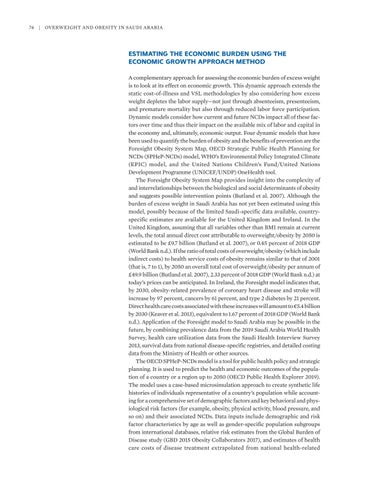74
|
Overweight and Obesity in Saudi Arabia
ESTIMATING THE ECONOMIC BURDEN USING THE ECONOMIC GROWTH APPROACH METHOD A complementary approach for assessing the economic burden of excess weight is to look at its effect on economic growth. This dynamic approach extends the static cost-of-illness and VSL methodologies by also considering how excess weight depletes the labor supply—not just through absenteeism, presenteeism, and p remature mortality but also through reduced labor force participation. Dynamic models consider how current and future NCDs impact all of these factors over time and thus their impact on the available mix of labor and capital in the economy and, ultimately, economic output. Four dynamic models that have been used to quantify the burden of obesity and the benefits of prevention are the Foresight Obesity System Map, OECD Strategic Public Health Planning for NCDs (SPHeP-NCDs) model, WHO’s Environmental Policy Integrated Climate (EPIC) model, and the United Nations Children’s Fund/United Nations Development Programme (UNICEF/UNDP) OneHealth tool. The Foresight Obesity System Map provides insight into the complexity of and interrelationships between the biological and social determinants of obesity and suggests possible intervention points (Butland et al. 2007). Although the burden of excess weight in Saudi Arabia has not yet been estimated using this model, possibly because of the limited Saudi-specific data available, country- specific estimates are available for the United Kingdom and Ireland. In the United Kingdom, assuming that all variables other than BMI remain at current levels, the total annual direct cost attributable to overweight/obesity by 2050 is estimated to be £9.7 billion (Butland et al. 2007), or 0.45 percent of 2018 GDP (World Bank n.d.). If the ratio of total costs of overweight/obesity (which include indirect costs) to health service costs of obesity remains similar to that of 2001 (that is, 7 to 1), by 2050 an overall total cost of overweight/obesity per annum of £49.9 billion (Butland et al. 2007), 2.33 percent of 2018 GDP (World Bank n.d.) at today’s prices can be anticipated. In Ireland, the Foresight model indicates that, by 2030, obesity-related prevalence of coronary heart disease and stroke will increase by 97 percent, cancers by 61 percent, and type 2 diabetes by 21 percent. Direct health care costs associated with these increases will amount to €5.4 billion by 2030 (Keaver et al. 2013), equivalent to 1.67 percent of 2018 GDP (World Bank n.d.). Application of the Foresight model to Saudi Arabia may be possible in the future, by combining prevalence data from the 2019 Saudi Arabia World Health Survey, health care utilization data from the Saudi Health Interview Survey 2013, survival data from national disease-specific registries, and detailed costing data from the Ministry of Health or other sources. The OECD SPHeP-NCDs model is a tool for public health policy and strategic planning. It is used to predict the health and economic outcomes of the population of a country or a region up to 2050 (OECD Public Health Explorer 2019). The model uses a case-based microsimulation approach to create synthetic life histories of individuals representative of a country’s population while accounting for a comprehensive set of demographic factors and key behavioral and physiological risk factors (for example, obesity, physical activity, blood pressure, and so on) and their associated NCDs. Data inputs include demographic and risk factor characteristics by age as well as gender-specific population subgroups from international databases, relative risk estimates from the Global Burden of Disease study (GBD 2015 Obesity Collaborators 2017), and estimates of health care costs of disease treatment extrapolated from national health-related






